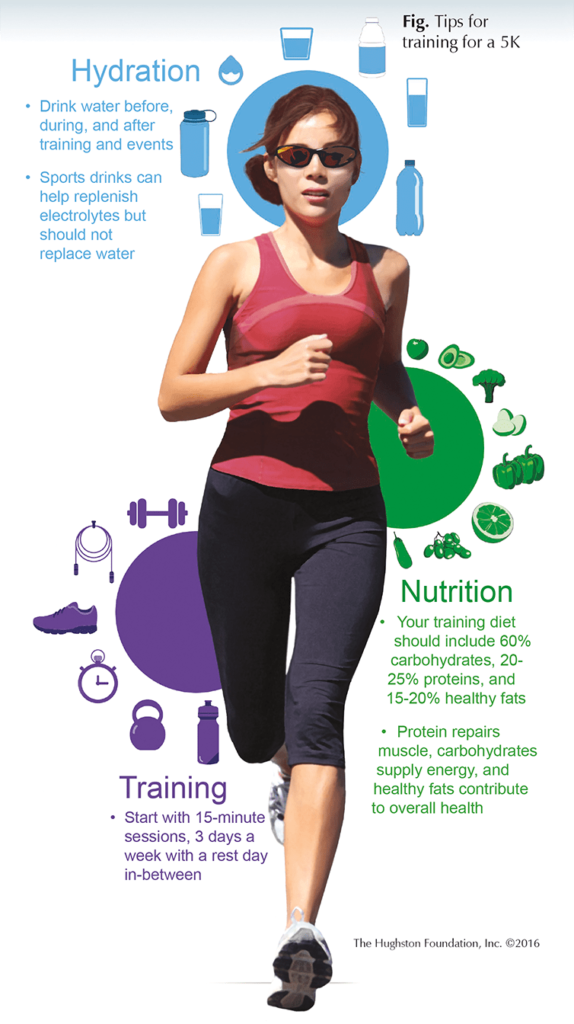
Thinking about training for a 5k?
As your feet pound the pavement, you become keenly aware of the hard reality of training for a 5K, or 3.1-mile, road race. While training for a 5K is challenging, it can also be fun and beneficial. Before you begin a training program, however, you will need to plan accordingly. First, particularly if you are over the age of 40, you should schedule a physical exam with your doctor to make sure you are healthy enough to train for and participate in this type of event. Next, to be sure you get the most out of your training, you will want to put a nutrition and hydration program into place. You can then establish a realistic timeline and sound strategy for training.
Nutrition for optimal performance and recovery

As you train for an athletic event, it can be easy to focus too narrowly on the physical aspects of training, but it is just as important to train nutritionally. If you do not fuel or hydrate adequately, your endurance and overall performance can be compromised. A comprehensive nutrition plan for training should include carbohydrates, protein, and healthy fats. You should also drink plenty of water (Fig.).
Fuel: Carbohydrates, proteins, and fat
Carbohydrates are a crucial dietary element as they supply the energy you need to run and work out. Ideally, calories from carbohydrates should make up at least 60% of your total calorie in-take. Some great carbohydrate choices are vegetables, fruits, whole grain breads, and pasta. Protein in appropriate portions constitutes another important component of your diet. Calories from protein should make up 20 to 25% of your total intake. Chicken, fish, eggs, beans, yogurt, low-fat cheese, and nuts are good, readily available sources of protein. Overall, eating protein along with energy-dense carbohydrates throughout endurance training has been shown to improve a runner’s performance; it has also been shown to decrease recovery time, probably because protein helps repair muscle tissue.
Fats also contribute to a runner’s general good health. But, because of the stigma associated with eating fat, figuring out which types are healthy to consume can be confusing. Your best bet is to choose the unsaturated, healthy fats found in avocados, almonds, cashews, and fatty fish, such as salmon or tuna, and to avoid saturated fats such as those found in lard and butter. Calories from fat should account for no more than 15 to 20% of daily calorie intake for the runner.
Hydration
Hydration is another key element of an optimal nutrition program for training and racing. Simply put, without adequate hydration, your body cannot function properly. It is therefore important to hydrate well by drinking plenty of water—in staggered amounts so as not to feel too full—before, during, and after training and events. You may even want to carry a water bottle with you while training or, alternatively, choose running routes in places, such as a park, where you can pass by a water fountain.
In the hours following a run or race, drink as much water as you can to rehydrate. When you are completely rehydrated, your urine will be a light yellow color. You can also use sports drinks to help replenish electrolytes—salts and minerals, such as sodium chloride and potassium, that control fluid balance and muscle contraction—but these should not replace water. The Summer 2016 issue (vol. 28, no. 3) of the Hughston Health Alert covers proper hydration for athletes in greater detail.
Training for a 5k: how much, how often
Once you have adopted an appropriate nutrition and hydration program, you can establish a training timeline and strategy. If you have not participated in any type of physical activity before, a realistic timeline for training to complete a 5K race would be 7 to 8 weeks. To allow both your cardiovascular and musculoskeletal systems to adjust to the new workload, you should train in a steady progression. For the first couple of weeks, mix walking and running, beginning with 15-minute training sessions, 3 days per week with at least 1 rest day in-between. Always adjust your running pace to be within your current fitness level.
As you move, you should have the breath to carry on a conversation; if not, you are trying to go too fast. In the coming weeks, as you become more comfortable with your routine, you can gradually increase the amount of running versus walking. You should also be able to increase your overall training time in 5-minute increments or your overall mileage in half-mile increments each week. However, always listen to your body, and if you become sore or fatigued, back off. As muscles actually grow stronger during rest and not during training, lack of rest can lead to fatigue and even injury. You may also want to stretch your muscles before and after running. This will help keep them flexible and may prevent injury. The Fall 2008 issue (vol. 20, no. 4) covers stretching techniques in greater detail.
The benefits of training
Running has been proven by research to improve your mood and reduce mental stress. As you exercise, your body releases chemicals called endorphins to the receptors in your brain, producing a sensation of overall well being. Moreover, regular running can help you lose weight because your body not only burns calories while you run, but also continues to burn extra calories afterward, a phenomenon known as excess post-exercise oxygen consumption (EPOC). Furthermore, running has been shown to strengthen your knees, keep you mentally sharp as you age, and to decrease your risk of developing diabetes mellitus, certain types of cancers, and cardiovascular disease, as well as increase the number of years you have to live.
Race day
As race day approaches, remember to adhere to the principles of fueling and hydrating well, particularly the day before. Continue to hydrate the morning of the race, but eat lightly or not at all; running forces the blood away from the stomach to the working muscles. During the race, run at a pace that feels comfortable and smooth. If you need to drink water on the course, slow up slightly to grab a cup at one of the water stations and sip. If you want to push yourself, wait until you are well past the second-mile marker and don’t sprint until you are past the third-mile marker. Once you are over the finish line, get the recovery process going by drinking plenty of water. As a rule of thumb, it will take your body a day for every mile raced—in this case, just over 3 days—to fully recover.
May the course stay with you
Training for a 5K race is an amazing journey that begins with planning and preparation. Success is based on a realistic timeline and sound training strategy along with a good nutrition and hydration program. Following these principles can lead you not only to the finish line, but also to improved physical and mental well being. By making running part of your everyday routine, you can continue to reap the benefits.
Author: Kamal Leak, MS, LAT, ATC, and Morgan Carr, MS, LAT, ATC | Columbus, GA
Reprinted with permission from the Hughston Health Alert, Volume 28, Number 4, Fall 2016.
Last edited on October 18, 2021